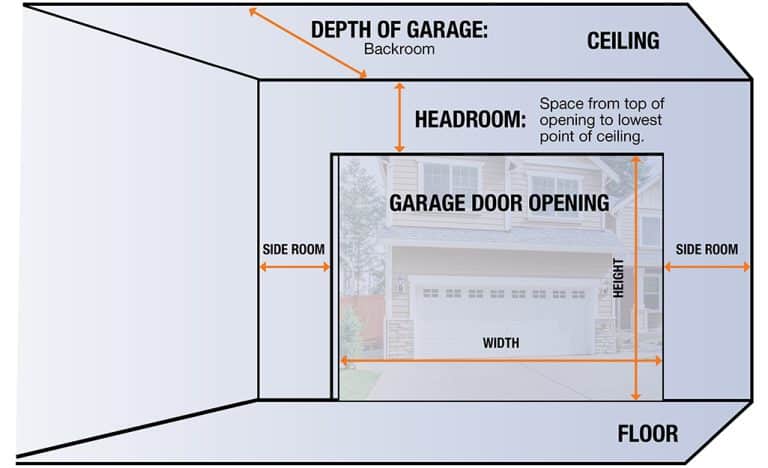Guide to Choosing the Ideal Width for Your Deck Steps

If you’re thinking about building a deck or already have one, you might be wondering, “How wide should deck stairs be?” Well, worry not because we’re here to guide you through this important aspect.
Curved Deck stairs are like pathways that connect your deck steps to the ground so you can go up and down safely. Having the right width for these stairs is important for both comfort and safety.
Think of using stairs that are too small; it wouldn’t be easy or safe, right? There are codes, which are like rules for building things, that tell us how wide deck stairs should be.
These codes make sure that stairs are wide enough for people to walk comfortably and securely. The exact codes might vary in different places, but they usually suggest a width of around 36 inches. This gives you lots of space to move without feeling crowded.
So, when you’re planning your deck stairs, remember to think about the codes and make them wide enough for a smooth and safe way between your deck steps and the great outdoors!
Size Codes for Deck Stairs Width
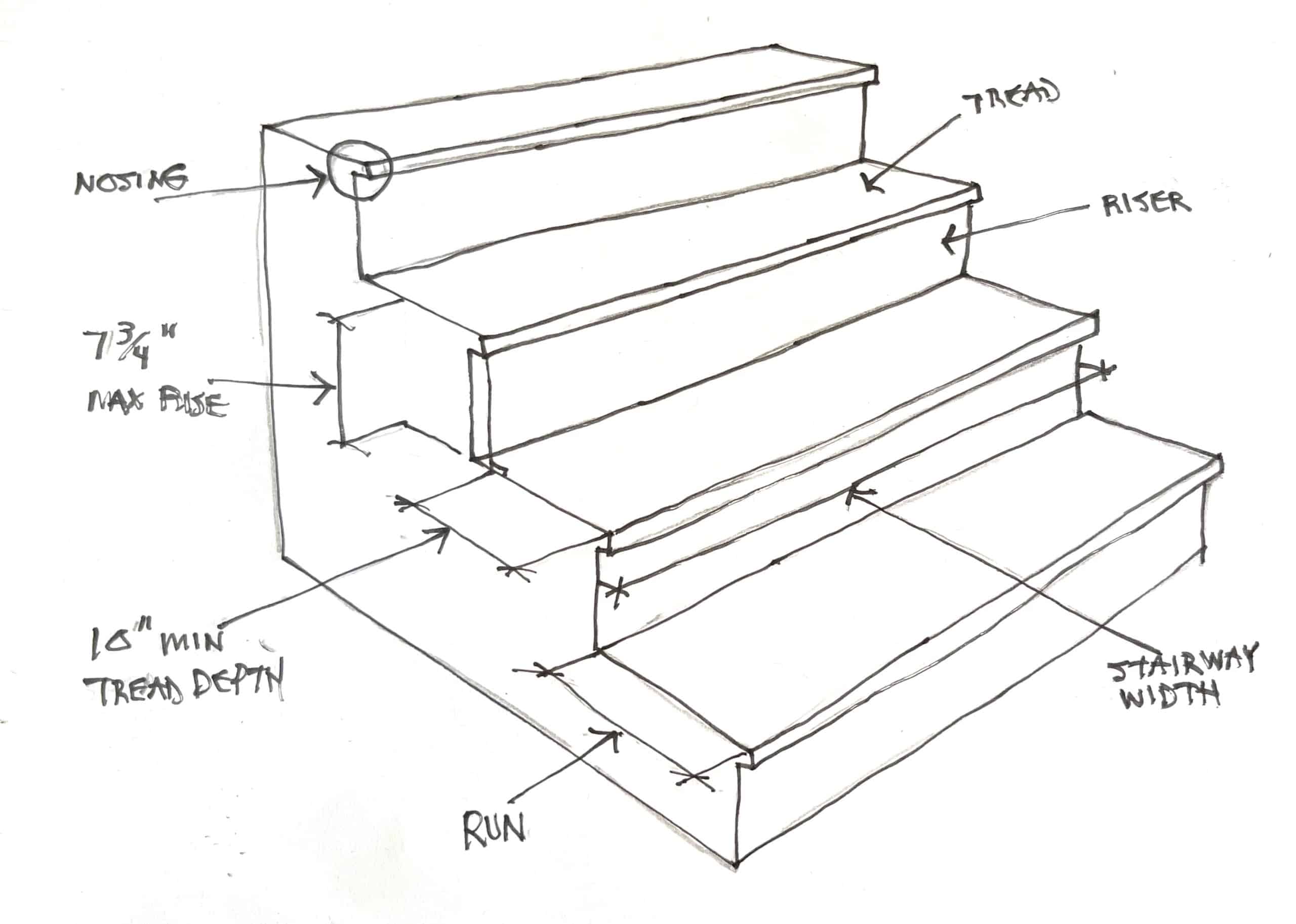
When constructing curved deck stairs, follow specific guidelines regarding their width, as this is important. These regulations play an essential role in ensuring safety and usability.
The International Residential Code (IRC) approves that deck stairs installation should be a minimum of 36 inches wide, including the necessary deck steps maintenance. This dimension provides sufficient space for individuals to come and go comfortably, even when carrying items.
However, an even greater width is desirable, as it improves the overall usability and convenience of the stairs.
1. Minimum Stair Width
The minimum width requirement for curved deck stairs is 36 inches. It’s important to ensure that the deck steps are wide enough to provide a safe and comfortable passage. This width not only helps people of various sizes but also allows for easier movement while carrying objects or crossing the stairs in different weather conditions.
2. Handrail Height Requirement
By following safety guidelines, maintain a minimum width of 36 inches of deck steps at all points above the authorized handrail height. This furnishing ensures that there is sufficient space for individuals to move without feeling tight or restricted, promoting a feeling of openness and security while using the deck stair construction.
3. Width Below Handrail on One Side
Where a handrail is present on one side of the stairs, a minimum width of 31.5 inches is required below the handrail height. This additional space offers a balance between safety and convenience. It enables individuals to comfortably hold the handrail while walking up or down the deck steps, thereby improving stability and ease of use.
4. Width Below Handrails on Both Sides
For staircases with handrails on both sides, the minimum width below the handrail height should be 27 inches. This dimension is designed to ensure that even in scenarios where users might need to hold onto either deck step handrail for support, there remains ample room for movement. Such considerations expect situations where individuals have different needs.
5. Maximum Rise and Difference Among Risers
To prevent any possible falling down hazards, add a maximum rise of 7-3/4 inches and a maximum difference of 3/8 inches among risers. This regulation contributes to the safety of the staircase, as desk steps minimize the risk of imbalance in step heights that could catch users off guard. This stability guarantees a smooth and predictable climbing experience.
6. Minimum Tread Width and Difference Among Tread
For each tread, maintain a minimum width of 10 inches and ensure a maximum difference of 3/8 inches among treads. This condition highlights both safety and comfort.
Stable tread dimensions reduce the likelihood of missteps, as individuals can rely on the ability to predict each deck step’s maintenance size. This is particularly beneficial when you come or go to the stairs regularly.
Right Height for Deck Steps
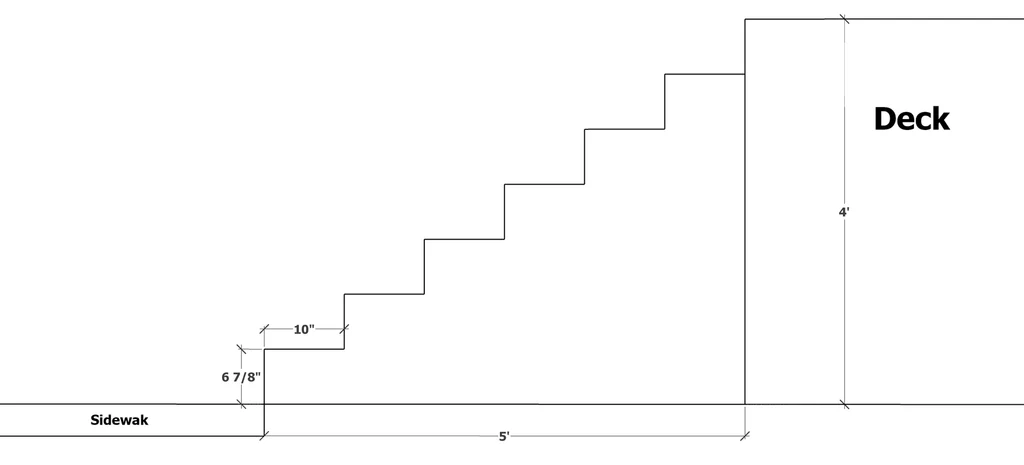
The measurement of each deck step height in curved deck stairs installation holds primary importance for both safety and comfort. The IRC presents a well-judged recommendation, maintaining uniform step heights within a staircase.
Going for a maximum step height of 7.75 inches is a wise approach. This measurement ensures that make way the stairs remain comfortable without subjecting the legs to excessive force.
How Deep Each Step Should Be
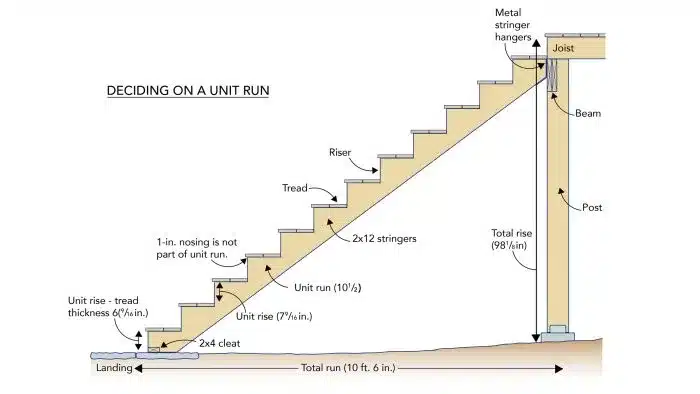
The section of the deck steps railing that you step on, referred to as the tread, is of utmost significance for safety considerations. As per the IRC guidelines, each step’s depth should measure at least 10 inches.
This requirement guarantees sufficient space for your foot, promoting comfort and stability during use. Stability in step depth across all stairs contributes to establishing a steady rhythm while you come or go.
Achieving the ideal balance between step height and depth not only increases the aesthetics of the stairs but also significantly upgrades their safety and user-friendliness.
Step Overview of Building Deck Stairs
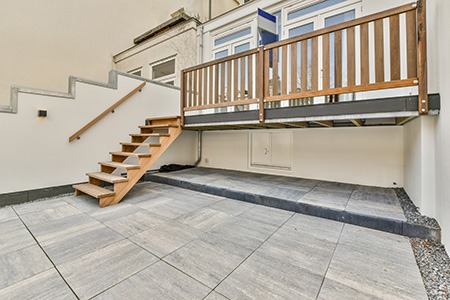
Step 1. Evaluate the Deck Dimensions for Compatibility
Before beginning the construction of curved deck stairs installation, it’s important to measure the dimensions of your deck space accurately.
This measurement ensures that the area is not only suitable for installing stairs but also allows for comfortable movement. By measuring the height from the ground to the top surface of the deck steps, you’ll have an essential value for later calculations and planning.
Step 2. Compute the Dimensions of The Tread and Risers
Treads, which are the horizontal deck steps you walk on, and risers, the vertical elements between treads, are both essential aspects of stair safety. Following established safety codes, it’s important to calculate the dimensions for treads and risers.
Generally, treads are designed to be around 10 to 11 inches deep, while risers should measure about 7 to 8 inches in height. This thoughtful sizing promotes a balanced and secure stride whenever you use the stairs.
Step 3. Designing Layouts and Conducting Test Fitments
Creating a clear and accurate plan is vital for a successful stair construction project. Shifting the calculated dimensions of your treads and risers onto the stringer, which is the notched support beam holding the deck steps railing, is the next step.
By outlining the pattern on a piece of lumber and verifying the measurements, you gain a representation of the stair design. This step is essential for identifying and addressing any necessary adjustments before progressing to the cutting phase.
Step 4. Cutting and Assembling the Stringer Notches
Cutting accurate notches into the stringer is a pivotal part of ensuring stability and safety in your stair assembly. The notches enable secure attachment to both the deck and the ground, providing crucial support for the individual steps.
Carrying off the careful cutting of these notches by your layout ensures a comfortable and secure fit against the structure of the deck. Once this is complete, you can confidently assemble the stringer, securing it firmly in place to guarantee a reliable stairway.
Step 5. Install the Handrail
Using a handrail in your stair construction improves safety and support and boosts the usability of the staircase. By attaching the handrail to the surface of the deck, you’re creating an additional layer of stability. It’s essential to verify that the handrail meets all local building codes regarding height and placement.
This accurate merge to regulations with the Handrail Bracket ensures that the handrail functions as planned, providing an easy-to-grip support structure for individuals ascending or descending the stairs.
Concrete Landings Required for Curved Deck Stairs
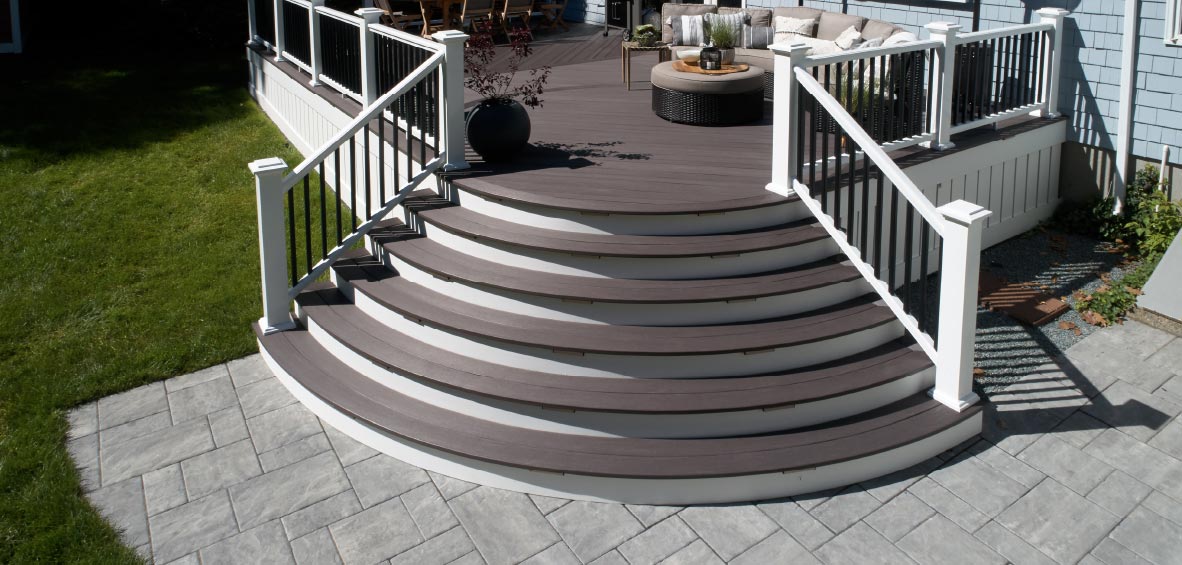
Curved Deck stairs installation is often required to land on a stable and durable surface, which can include concrete. This provides a solid and inflexible foundation that easily prevents sinking or shifting, ensuring the long-term structural personality of the stairs.
Additionally, the chosen landing surface should be not only useful but also look pleasing, combined with the overall design of the deck steps railing and its surroundings.
Moreover, the landing serves as a vital point that bridges the gap between different segments of the stairway. Unlike the steps themselves, the landing is not counted as a step. Instead, it offers a spacious platform that acts as a resting spot between sets of deck steps.
Proper Spacing Between Stair Stringers
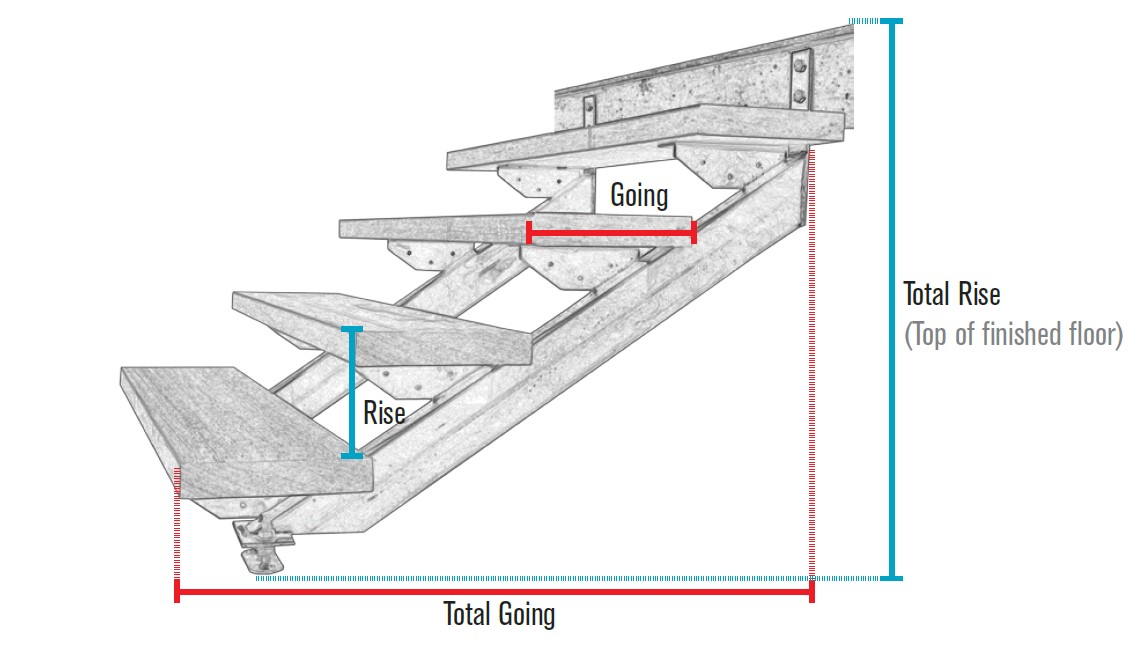
Stair stringers, which play an important role in upholding the staircase’s stability and supporting the capacity, should ideally be spaced at a maximum interval of 18 inches. This exact spacing measurement is essential in maintaining the overall personality of the stair structure.
Ensuring that the stringers are not too widely spaced increases the risk of steps becoming weak or unstable over time. This wise spacing approach, applicable to deck steps as well, also guarantees consistent weight distribution across the stairs, increasing their fitness and durability for long-term use.
Number of Steps Required for Deck Railing
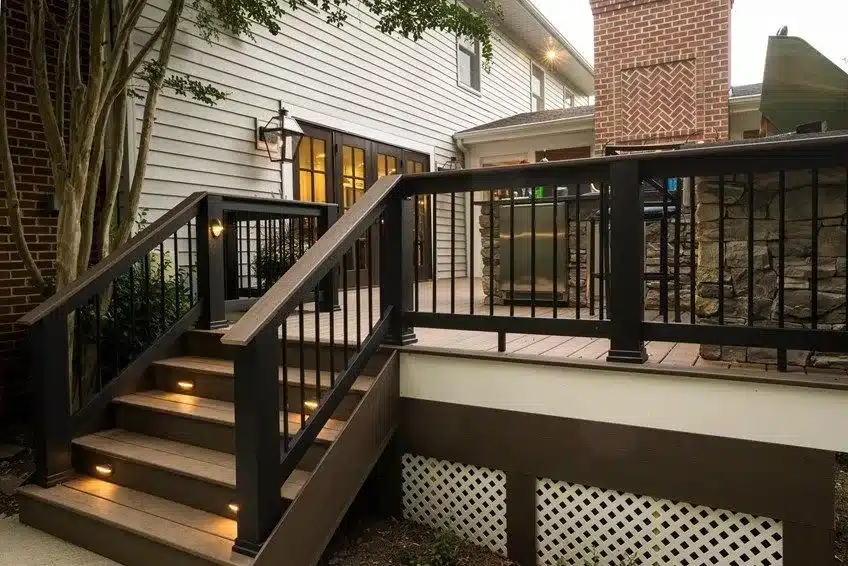
In matters of safety and compliance, a general guideline dictates that if your deck steps railingfeatures four or more steps, the addition of a handrail becomes a basic need. The handrail’s purpose is two-fold: it acts as a preventive measure against possible accidents, and it offers major support for those using the stairs, including deck steps maintenance.
To secure safety regulations, the handrail should be designed to be easily gripped, and it must be installed at a specific height that ensures the best usability and comfort.
Wrapping It Up
When it comes to the width of deck stairs, following the codes is important for safety and usability. The codes usually say that stairs should be about 36 inches wide or even wider.
By keeping an eye on these codes and guidelines, you’re not just sticking to requirements; you’re also taking a step towards creating deck steps that are welcoming and secure for everyone. This gives enough room for people to easily walk up and down, even if they’re carrying things.
Remember, wider stairs are better because they’re safer and easier for everyone, including kids and older people. And don’t forget to have handrails for extra support.
So, whether you’re making new stairs or improving the ones you have, it’s smart to follow the width rules. This makes sure your outdoor stairs are safe and easy for everyone to use.
Remember to check your local rules, too, as they might be a bit different. With wider and safer deck stairs, you can enjoy your outdoor space without worries.
Frequently Asked Questions
What is the Recommended Width for Deck Stairs?
The recommended width for deck stairs is generally around 36 inches (91.4 cm). This width provides enough space for safe and comfortable passage while carrying items or walking up and down the stairs.
Can Deck Stairs Be Wider than The Recommended 36 Inches?
Yes, deck stairs can be wider than 36 inches as long as they merge with local building codes. Some codes might have maximum width limits to prevent excessive width that could hinder the structural integrity of the stairs or take up too much space on the deck.
Can I Build Narrower Stairs for a Small Deck?
While narrower deck stair construction might seem suitable for a small deck, it’s important to combine it with local building codes. Even on a small deck, safety should be a priority, and the stairs should provide adequate space for users.
Are There Any Handrail Requirements Related to Deck Stair Width?
Yes, building codes often require handrails on deck stairs. The handrails should be of a certain height and provide a secure grip. The presence of handrails might also affect the effective width of the stairway.
How Do I Find out The Specific Building Code Requirements for Deck Stairs in My Area?
Contact your local building department or authority to obtain information on the exact building code requirements for decks in your region. They can provide you with the most up-to-date and accurate information.
Can I Modify the Existing Deck Stairs that Do Not Meet the Recommended Width?
If your existing deck stair construction does not meet the recommended width or building code requirements, it’s advisable to consult a professional before making any modifications. They can guide you on how to bring your stairs up to code while ensuring safety and stability.





